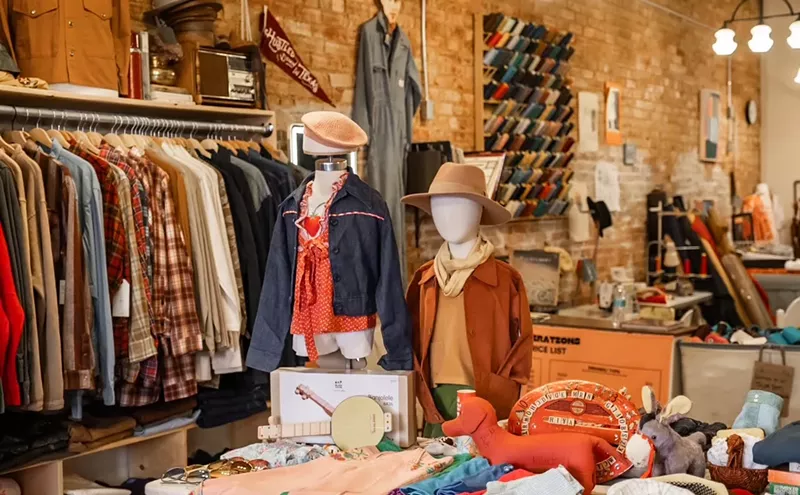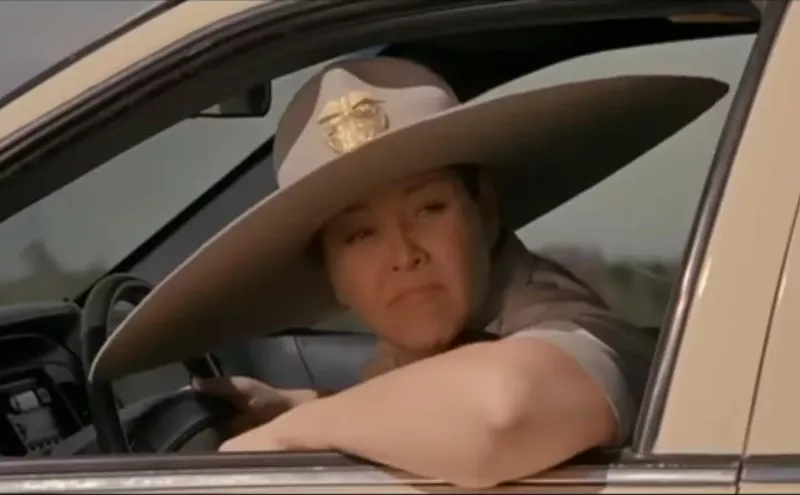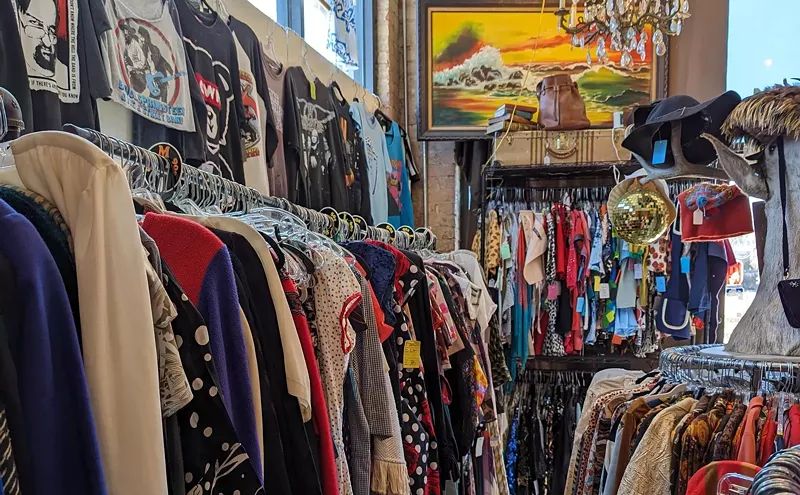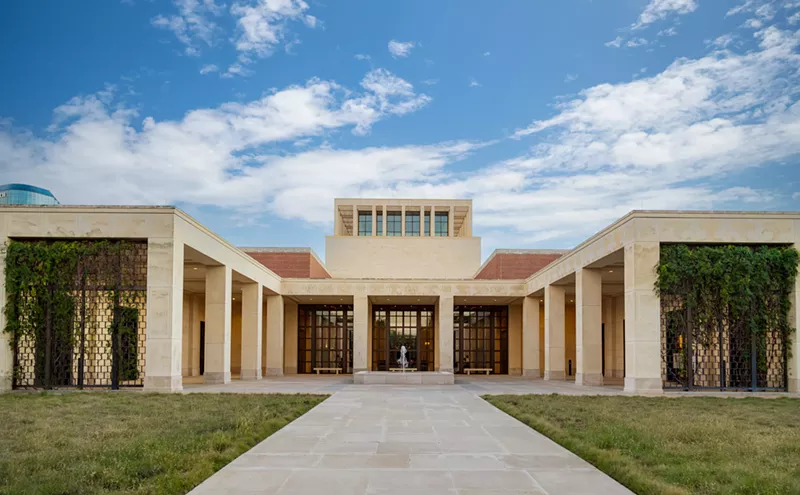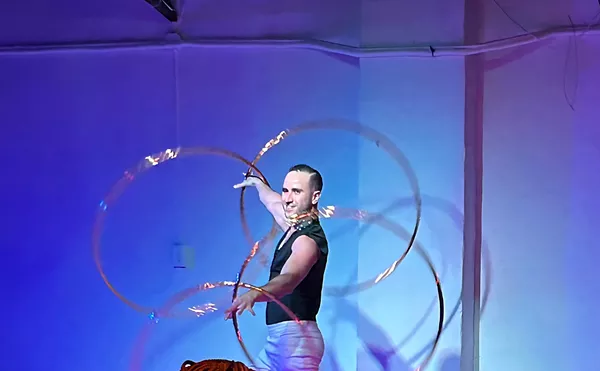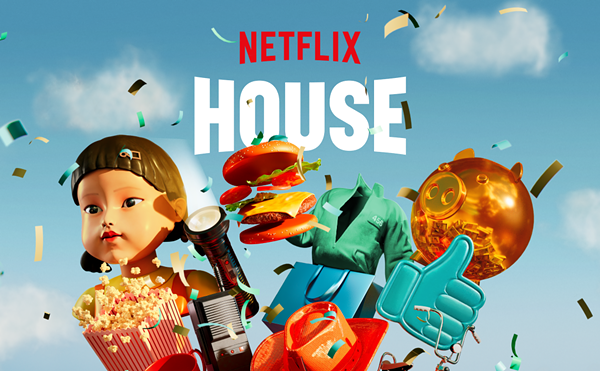I was fascinated. Not by the show; for those of us who live and work in flyover territory, especially, a Chihuly show or installation is never far. From Vegas to Miami, from Seattle to Big D, his "Persians" and "Chandeliers" constitute a bright and cheerful form of public wallpaper. But here was my mother, a woman who still considers Impressionism adventurous, lobbying to drive hours to see a glassblower with minimalist and conceptual roots. This is a woman who sends me Hallmark birthday cards with kittens and collects tiny Swarovski animals and has been known to put up floral wallpaper. I mean, I love my parents, and they're good people and salt of the earth and all that, but visual sophisticates they aren't. When I was growing up, they splurged on an original work of art, and so I was forced to spend my formative years staring up at a portrait of a Spanish conquistador painted on black velvet. I think you get my drift.
Anyway, it turns out my mother loves Chihuly. Hell, even my 91-year-old grandmother, whose notion of art encompasses nothing post-Gainsborough, would like the huge, brightly colored basket sets and "Venetians" now on view at Pillsbury and Peters--though if you pressed her, she'd probably find the palette a little gaudy. The point is, Chihuly has scaled the summit of Middle-American popularity, entered that not-so-select but admittedly tiny clique of artists whose work is widely recognized by the hoi polloi. He is enshrined in the popular consciousness alongside Warhol and Peter Max and George Rodrigue, the Blue Dog dude.
None of this is hard to explain. Although Chihuly started out in the '60s and '70s making difficult conceptual installations and theoretical hybrid forms--weaving glass into textiles, pouring glass and plastic into mountain crevices--he long ago abandoned these visually challenging forms. For the past 20 years he has produced mostly decorative, Oriental, neo-baroque glass objects, brightly colored and in vaguely organic shapes. Accessible, pretty and undemanding, they are handmade by guys with skills not just everybody has (a team of glassblowers makes them under Chihuly's supervision). Unlike Pop and conceptual art, they don't leave viewers with the uneasy feeling that someone's putting something over on them, don't inspire fear of inside jokes. In short, Chihuly's glass figures are pretty close to Everyman's notion of what art should be.
The amazing part is that the critics have gone along. To review the Chihuly literature is to be struck by the near absence of dissenting opinions; Chihuly has spawned some of the most overheated critical prose in circulation. To art critic Donald Kuspit, Chihuly's work is nothing less than a psychological breakthrough. Barbara Rose calls Chihuly "an artistic Superman" who "has the gift of restoring to us what contemporary culture robs us of: delight, wonder, amazement." Other scribes, many of whom smacked Warhol around for toadying up to the rich and powerful, or damned Koons' "cynical" pandering, are on the record cooing over Chihuly's Kaprowesque but immensely popular public stunts, such as filling a public skating rink with colored neon frozen in ice blocks, or hanging "chandeliers" all over Venice. Like Thomas Kinkade, Chihuly delights in his public, often citing attendance figures and bragging that his publicly staged spectacles are free. And for this, perversely, the critics love him. "He has proved," Rose writes, rather disingenuously, "that he does not need the approbation of the high priests of the art world to survive and prosper."
What gives? Simple: The eggheads have presented the issue bass-ackwards. The interesting thing is not that Chihuly doesn't need the machinery of Art; it's that culture's guardians, panicked over a three-decade-old disconnect between art and museum-going audiences, have convinced themselves they need Chihuly. This panic surfaces most visibly in art-world arguments over "beauty," the byword of the moment. Dave Hickey, art's hottest theoretician and the recent recipient of a MacArthur genius grant, has identified beauty--"the agency that causes visual pleasure in the beholder"--as "the issue of the '90s." Though others have since jumped on the bandwagon, it is Hickey who, bless his blunt-spoken ex-pat Texas heart, puts the matter most directly. In his view, art's legitimacy derives from its being a democratic process, dealing and collecting being merely capital-intensive forms of voting.
It seems we have come a full 180 degrees from the day when Clement Greenberg could cripple a career by sniffing that the work wasn't "important." Today, art critics care more about turnstiles than the judgments of history; snobbery is out, populism in. We have abandoned the art-is-good-for-you principle, ironically, the very justification for putting museums in the hinterlands. It isn't enough for culture to educate. Museums are now supposed to be fun, an entertainment to rival movies and video games. You don't even have to learn anything while you're there; you can see pretty glass and bright colors and recognizable shapes and still get home in time to see the Cowboys game. Haute hedonism is the order of the day, and Chihuly perhaps its most visible and seductive proponent. As Barbara Rose so accurately notes: "There is no program for progress in Chihuly's work, no apology for luxury, no moralistic reformist diatribe, no progressive agenda." In short, Chihuly, while being inventive and entertaining and dedicated and doubtless a perfectly nice guy, is really an art-world devil.
Before I am accused of Puritanism, let me say that Chihuly is not pure evil. His public installations, especially his experiments at locales like the Stewart Williams House in Palm Springs, are visually interesting. He has done his part to question false distinctions between craft and fine art. And there is nothing wrong with the notion of bringing art to the masses, a time-honored artists' conceit, quaint and quixotic and smelling only vaguely of a mildewed Utopia. But by advocating a diet of nothing but eye candy, Chihuly compromises art's standards ever so slightly--a process that, in the end, leads us into temptation, into a betrayal of art's possibilities. He denies us the pleasure of being puzzled, of being intrigued or curious enough to sally forth into the books and learn. He denies us the joy of looking long and hard, of gradually seeing parts unfold and figuring out how they fit into the whole, of solving visual conundrums.
The notion that art doesn't have to be difficult, or challenging, or even make you think is nothing more than voodoo art history, a bait-and-switch tactic that takes full advantage of art's exalted status without delivering the goods. For this reason, and this reason alone, viewing the bonbons at Pillsbury and Peters' show is not even as satisfying as a trip to the aquarium, where at least the creatures are real and we can scratch our heads over the higher purpose of this color or that shape. In the end, Dale Chihuly turns out to be to art what fashion and entertainment correspondents are to the legitimate press: an unfortunate and embarrassing lowering of discourse, a sad effort to atone for art-world excesses by pandering to nitwits.



